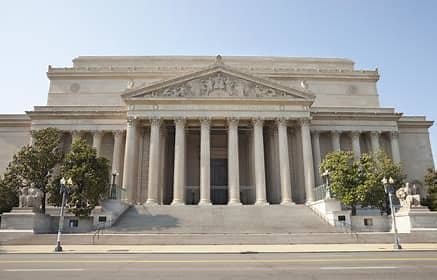People die. That’s the thing about mortality. The Founding Fathers were no different. Fortunately, their legacy lives on in the documents they created. Yet, who is responsible for ensuring these, and the countless other government documents, are preserved and maintained? In this post, we are going to discuss the entity charged with this duty, the National Archives, and why you should visit while you are in Washington, DC. But first, let’s talk a little about the National Archives’ history.
The History
In 1934, Congress established (and President Franklin D. Roosevelt signed into law) the National Archives in order to create a centralized system for preserving and managing U.S. Government records. Prior to this, there was no standard for federal recordkeeping. Important documents were often stored in poor conditions, scattered across various buildings without proper security or care. The need for a dedicated institution became evident as historical and legal documents faced deterioration or loss due to inadequate storage practices. The National Archives provided a solution, ensuring that vital records were safeguarded and accessible for future generations.
The National Archives Building actually began construction prior to Congrees establishing the National Archives. In 1926, Congress passed the Public Building Act, providing for the construction of several government buildings including a National Archives. Ground was broken on the building in 1931 and then President Herbert Hoover laid the cornerstone in 1933. Talk about putting the cart before the horse!
The National Archives has expanded far beyond simple record-keeping at our nation’s capital. Today, it oversees multiple facilities across the country to include the Presidential Libraries. The institution has also adapted to modern technology to include preserving electronic records.
The National Archives (now the National Archives and Records Administration, or NARA) mission sums up its importance perfectly:
“NARA’s mission to provide public access to Federal Government records in its custody and control. Public access to government records strengthens democracy by allowing Americans to claim their rights of citizenship, hold their government accountable, and understand their history so they can participate more effectively in their government.“
The National Archives is a treasure chest of federal documents. And it has some epic ones on display.
The Experience
When it comes to visiting the National Archives, the Rotunda is where you want to be. It’s here that houses the Declaration of Independence, Constitution, and Bill of Rights, collectively known as the Charters of Freedom. The Rotunda is also home to an original 1297 copy of the Magna Carta.

The Rotunda is open daily to the public from 10 am to 5:30 pm. The entrance is located at 701 Constitution Ave near many of the Smithsonian museums. Like many of the places in DC, admission is completely free. You will have to go through security screening. Photos are allowed, but no flashes. Dedicate anywhere from 30 to 90 minutes here, depending on how much you want to read about the documents on display.
Why You Should Visit
Think about this for a minute. In one room, you can view the three most important documents in creating the United States. Ben Franklin signed that Declaration of Independence. Alexander Hamilton signed that Constitution. Plus, don’t sleep on the importance of the Magna Carta. The Founding Fathers drew heavily upon it to define what liberty meant. Wow, just wow.

George Washington, John Adams, and Thomas Jefferson may be gone, but we have the opportunity to see firsthand the legacy they and many others left behind. Thanks to the National Archives, documents such as the Charters of Freedom remain well-preserved and on display all in one place for us to enjoy.
Related Posts
What are the Presidential Libraries and why are they important?

One response to “The National Archives: A Document Treasure Chest”
[…] The National Archives: A Document Treasure Chest […]